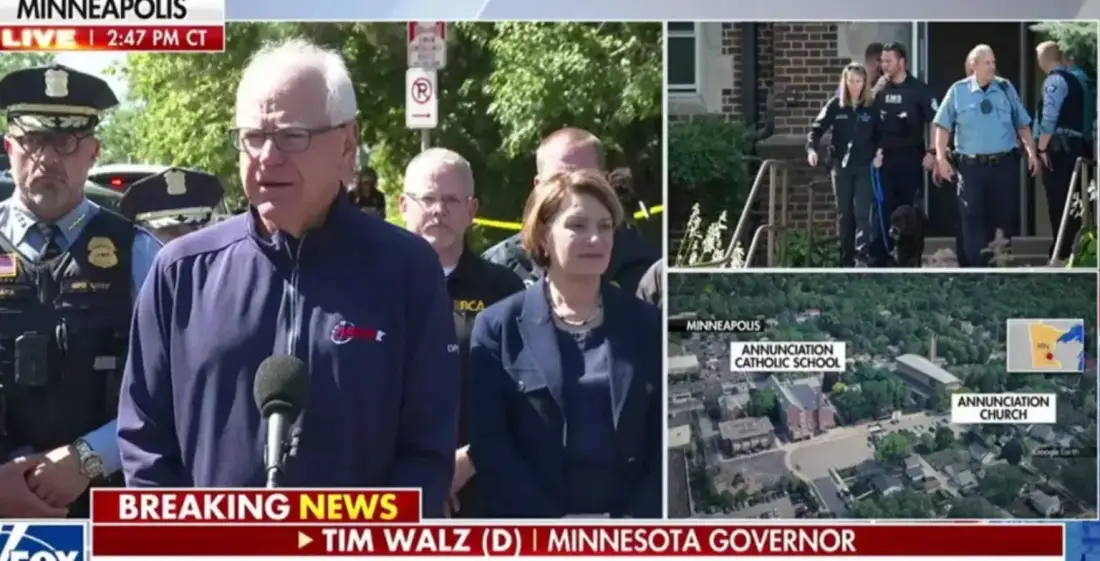A Sacred Space Shattered
It began as an ordinary Wednesday evening service inside Annunciation Catholic Church in Minneapolis. Families filled the pews. Children fidgeted and whispered while their parents tried to keep them still. Hymns drifted through the sanctuary, voices rising with faith and familiarity. For the congregation, it was a moment of peace — a break from the noise of everyday life.
But peace has grown fragile in America, and within moments, the sanctuary of worship became a place of horror. The echo of gunfire cut through prayers. Screams replaced hymns. People ducked under pews, clutching their children, searching for safety in a place where safety had always been assumed.
When it was over, two children lay dead. Eighteen others were wounded, fifteen of them also children. The gunman — later identified as 23-year-old Robin Westman — turned the weapon on himself, ending his own life and leaving behind only devastation, confusion, and grief.
What should have been an evening of worship had become another headline in America’s ongoing story of violence, and the reverberations extended far beyond the city of Minneapolis.
Part II: A Search for Blame
In the days after the shooting, families mourned, police investigated, and politicians searched for someone to hold accountable. The grief was undeniable, but so was the anger.
Former Secret Service agent Rich Staropoli, appearing on Fox News’s The Ingraham Angle, did not hold back. His words sparked a firestorm:
“This guy has gone so far out of his way to provide top cover and support for a group of people who are the most mentally unbalanced group of people in the entire world,” Staropoli said, directly criticizing Minneapolis Mayor Jacob Frey.
He wasn’t finished.
“The left created this shooter. Jacob Frey and his ideologies, coupled with his rantings about how Trump and his Nazi-like dictatorship has created an environment where the transgender community will be erased by the Catholic Church, that’s what prompted this kid to go out and shoot up that church today.”
The accusation was staggering — an attempt to tie local leaders’ support for transgender communities and progressive policies directly to a deadly act of violence. Staropoli’s framing went beyond a critique of leadership. It was an indictment, suggesting that political rhetoric and cultural clashes had spilled into bloodshed.
Gov. Tim Walz, whom Staropoli mockingly dubbed “Tampon Tim,” was also targeted in the tirade. The charge was simple, though explosive: that Democratic officials had cultivated an environment in which someone like Westman could justify violence.
For conservatives, it was a powerful talking point. For liberals, it was reckless scapegoating. For grieving families, it was another layer of chaos on top of unbearable loss.
Part III: A Shooter’s Troubled Background
Investigators quickly began piecing together Robin Westman’s life. The portrait that emerged was complicated, unsettling, and politically volatile.
Court documents revealed that in 2019, Westman’s mother applied for him to legally change his name, writing: “minor identifies as female and wants her name to reflect the identification.” That detail alone became a lightning rod. For conservatives, it seemed to bolster claims that mental instability tied to gender identity had played a role. For progressives, it was proof of the dangers of stigmatizing already vulnerable individuals.
Police disclosed that they had linked Westman to three different residences but could not immediately determine where he was living prior to the attack. Investigators also uncovered digital traces — online writings, social media rants, and posts suggesting a growing anger toward both the Catholic Church and conservative politicians.
Staropoli had claimed the attack was “festering and growing for months.” Evidence seemed to support that timeline. Family members described a person increasingly consumed by political rhetoric, torn between feelings of marginalization and resentment.
And yet, while law enforcement scrambled to fill in the details, the gunman’s mother refused to cooperate.
Part IV: A Mother’s Silence
When tragedy strikes, families are often the first to provide insight. But in this case, investigators hit a wall.
Westman’s mother, Mary Grace Westman, hired prominent criminal defense attorney Ryan Garry almost immediately after the shooting. According to Garry, she was “completely distraught about the situation and has no culpability.”
Police chief Brian O’Hara acknowledged that despite “dozens of interviews” with friends, coworkers, and family members, the mother had not cooperated. That silence raised eyebrows. Why would a grieving parent refuse to help investigators understand what drove her child to violence?
To some, it signaled fear — perhaps of legal exposure, perhaps of public judgment. To others, it was proof that something darker lingered in the background of this case. Was she protecting her son’s memory? Was she hiding knowledge of his intentions?
The refusal only fueled political fire. If Staropoli’s accusations painted progressives as complicit in the shooting, the mother’s silence suggested a family unwilling to confront the reality of what their son had become.
Part V: The Political Firestorm
Every mass shooting in America now triggers not just grief, but a battle over narrative. The Minneapolis tragedy was no exception.
For Republicans, the shooting highlighted what they framed as dangerous left-wing ideology — a permissive environment that ignores mental health warning signs and promotes cultural agendas over public safety. For Democrats, the blame was reversed. They pointed to the easy access to firearms, the lack of effective gun laws, and the toxic rhetoric that pits communities against each other.
In Washington, lawmakers clashed over how to frame the event. Conservatives echoed Staropoli’s charges, suggesting that leaders like Frey and Walz had “blood on their hands.” Progressives accused Republicans of weaponizing a tragedy to smear vulnerable communities.
Caught in the middle were the families of the victims — two children killed, fifteen others injured, and a congregation forever traumatized.
Part VI: Community in Mourning
At Annunciation Catholic Church, the focus was less on politics and more on healing. Vigils were held outside the church, candles flickering in the autumn air as parents wept for their children. Pastors urged forgiveness but also accountability.
The Archbishop of St. Paul and Minneapolis called the shooting “an attack on the most sacred of spaces” and reminded the faithful that “evil does not have the final word.”
But the wounds were deep. For many parents, trust in the sanctuary had been shattered. The idea that their children could die in the pews of a Catholic mass was unthinkable.
Part VII: The Unanswered Questions
Even as the FBI and Minneapolis police continued their investigation, questions piled up:
-
What, exactly, motivated Westman to target the church?
-
Did political rhetoric from either side of the aisle influence his actions?
-
Could his family have intervened earlier, and if so, why didn’t they?
-
What role did mental health struggles or issues of identity play?
No clear answers emerged. But what was clear was the way the tragedy had been absorbed into America’s broader cultural wars.
Part VIII: A Nation at a Crossroads
The Minneapolis church shooting was not the first mass killing in America, and tragically, it won’t be the last. But its timing, its setting, and its political fallout made it uniquely combustible.
Staropoli’s words on Fox News reflected a growing tendency to assign political blame for violence rather than searching for root causes. His charge that “the left created this shooter” may resonate with some, but it also risks oversimplifying the complex web of factors that drive individuals to commit horrific acts.
At the same time, Democrats face their own credibility gap. Calls for gun control remain urgent, yet the persistence of mass shootings leaves many skeptical that policy alone can solve a cultural crisis.
As America moves forward, the Minneapolis tragedy will linger as both a wound and a warning — a reminder of how fragile safety has become, and how quickly grief can be weaponized into politics.
Conclusion: Between Grief and Blame
The children killed that Wednesday night will never grow up. The parents who carried them into Annunciation Catholic Church will forever carry the memory of their final moments. That reality cannot be changed, no matter how the politics unfold.
But the story does not end at the church doors. It stretches into the halls of Congress, the studios of cable news, and the debates about who is responsible for America’s violence.
Perhaps the saddest truth is this: while leaders trade accusations and families grieve in silence, the cycle threatens to continue. Unless the nation finds a way to look beyond blame and address the deeper fractures in its culture, tragedies like Minneapolis will remain an all-too-familiar chapter in America’s story.

Ethan Blake is a skilled Creative Content Specialist with a talent for crafting engaging and thought-provoking narratives. With a strong background in storytelling and digital content creation, Ethan brings a unique perspective to his role at TheArchivists, where he curates and produces captivating content for a global audience.
Ethan holds a degree in Communications from Zurich University, where he developed his expertise in storytelling, media strategy, and audience engagement. Known for his ability to blend creativity with analytical precision, he excels at creating content that not only entertains but also connects deeply with readers.
At TheArchivists, Ethan specializes in uncovering compelling stories that reflect a wide range of human experiences. His work is celebrated for its authenticity, creativity, and ability to spark meaningful conversations, earning him recognition among peers and readers alike.
Passionate about the art of storytelling, Ethan enjoys exploring themes of culture, history, and personal growth, aiming to inspire and inform with every piece he creates. Dedicated to making a lasting impact, Ethan continues to push boundaries in the ever-evolving world of digital content.
